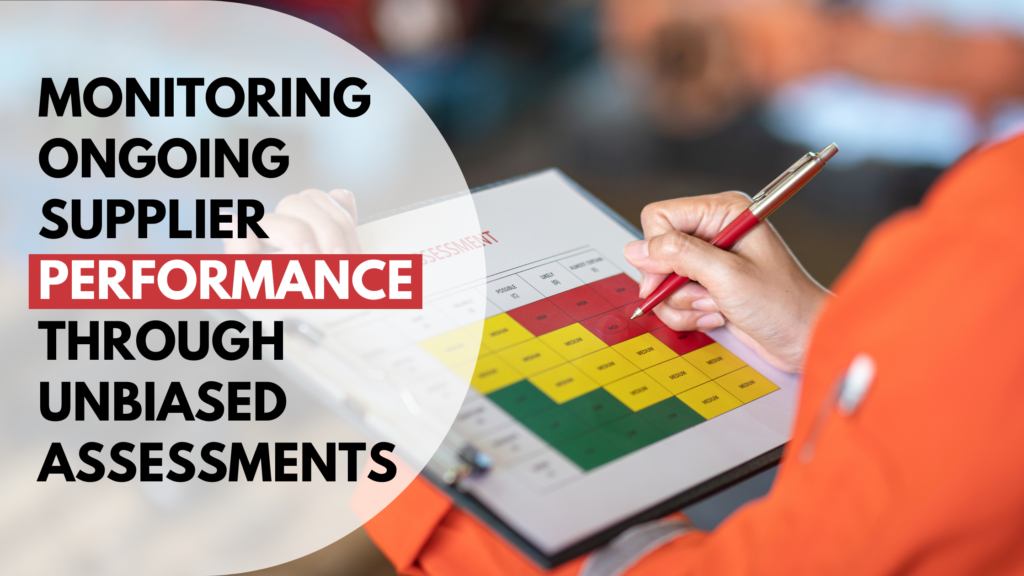Monitoring Ongoing Supplier Performance Through Unbiased Assessments
Monitoring supplier performance is a critical process that ensures suppliers meet predefined standards and expectations, crucial for the continuity and success of business operations. It involves a comprehensive evaluation of supplier deliverables, focusing on key metrics such as on-time delivery, quality, and cost. This vigilant approach not only aids in pinpointing areas that require improvement but also significantly mitigates the risk of disruptions, ensuring supplies align seamlessly with the business’s needs. Implementing impartial, routine assessments through voice of customer data, process audits, and scorecards is essential for monitoring post-vetting performance, providing a structured pathway to achieve optimal supply chain efficiency.
The Significance of Regular Supplier Assessments
Conducting regular supplier assessments is paramount for any business aiming to foster growth and maintain a competitive edge. These evaluations serve multiple crucial functions:
Assessing Supplier Capabilities: Understanding a supplier’s performance, reliability, quality, production capacity, and environmental impact is essential. This comprehensive view aids in making informed decisions and adjustments where necessary.
Visibility and Risk Mitigation: Regular assessments bring visibility into supplier performance, helping to identify areas of risk early on. This proactive approach is vital in building trust, transparency, and a robust supply chain that can withstand various challenges.
Strengthening Relationships: By continuously monitoring and evaluating supplier performance, businesses can enhance these relationships. This ongoing dialogue encourages suppliers to maintain or improve their standards, leading to mutual growth and success.
Moreover, implementing impartial, routine assessments through voice of customer data, process audits, and scorecards is crucial. This structured approach ensures that evaluations are based on objective criteria, aligning with the company’s strategic goals and fostering a culture of continuous improvement.
Setting Clear Expectations with Your Suppliers
To ensure clarity and mutual understanding between businesses and their suppliers, setting clear expectations is paramount. This process begins with the meticulous outlining of the project’s scope, deliverables, and standards directly within the contract. Key Performance Indicators (KPIs) should be specified, alongside the frequency of evaluations, participants involved, and the consequences of underperformance or non-compliance. This structured approach not only sets a solid foundation for the relationship but also aligns both parties toward common goals.
Communication Plan:
- Frequency of communication
- Preferred modes (Email, Calls, Meetings)
- Purpose and topics of discussion
Regular Reviews:
- Scheduled meetings/calls to review progress
- Discussion on challenges and feedback provision
- Collaborative approach to problem-solving
Incorporating a fair and consistent application of KPIs and criteria across all suppliers ensures impartiality. Utilizing reliable, verifiable data to support evaluations minimizes subjectivity, fostering a culture of transparency and trust. Prompt, respectful feedback after evaluations and a collaborative stance on resolving disputes further solidify this relationship. By regularly soliciting feedback from suppliers and acknowledging their contributions, businesses can foster a partnership that encourages continuous improvement and innovation. This approach not only enhances supplier performance but also contributes to the overall success and sustainability of the supply chain.
Developing an Effective Supplier Evaluation Framework
Developing an effective supplier evaluation framework is a multifaceted process that necessitates a structured and methodical approach. The core of this framework revolves around:
Types of Evaluations: Utilizing a mix of scorecards, questionnaires, discussions, and vendor visits ensures a comprehensive understanding of supplier performance. Each type serves a unique purpose, from quantifying performance metrics on scorecards to gaining in-depth insights through on-site visits.
Performance Indicators and Supplier Segmentation:
- Identifying critical performance indicators such as on-time delivery rates, cost competitiveness, and product quality is essential. These indicators provide a quantitative basis for comparison across different suppliers.
- Supplier segmentation further refines the evaluation process by categorizing suppliers based on their strategic importance and impact on operations. This can be achieved through the ABC analysis method, categorizing suppliers into groups A, B, and C, which helps prioritize monitoring efforts.
Continuous Evaluation Process:
- Pre-qualification and Regular Assessments: Supplier evaluation is both a pre-qualification step and a continuous process. Initial assessments ensure suppliers meet the necessary standards, while ongoing evaluations monitor for consistency and areas of improvement.
- Criteria Weighting and Scorecard Adjustments: Assigning weights to different evaluation criteria according to organizational priorities ensures that assessments are aligned with strategic goals. Regularly updating these criteria and their weights keeps the evaluation process relevant and effective.
Incorporating impartial, routine assessments through methods such as scorecards and process audits, as part of the supplier evaluation framework, ensures a consistent and unbiased approach to monitoring supplier performance. This structured evaluation not only facilitates effective supplier management but also aligns supplier objectives with the overarching company strategy, fostering a collaborative environment for continuous improvement.
Key Factors to Consider in Supplier Evaluations
In evaluating suppliers, several key factors must be meticulously considered to ensure an unbiased assessment and continuous improvement in supplier performance. These factors can be broadly categorized into Quality, Capacity, Risk, and Environmental Impact, among others, each contributing to a comprehensive understanding of a supplier’s capabilities and potential risks.
Quality and Reliability:
- ISO BS/EN ISO 9001:2000 certification
- Quality management system and control processes
- Performance history and product/service specifications
Capacity and Financial Stability:
- Ability to scale production in response to company needs
- Current production levels and processes
- Inventory management practices and financial stability
Risk Assessment:
- Material shortages, human-caused and natural disasters
- Overall delays, average response time, and corrective actions
- Market fluctuations, image, and compliance risks
Environmental Impact and Sustainability:
- Waste management strategies and reduction practices
- Efforts to achieve energy efficiency
- Handling of harmful materials and procurement procedures
Additionally, cost and pricing should not be evaluated in isolation but considered alongside these factors to ensure a balanced and comprehensive supplier evaluation. This approach aligns with the organization’s mission, vision, and business goals, facilitating a partnership that fosters mutual growth and sustainability.
Facilitating Successful Supplier Assessments
Facilitating successful supplier assessments hinges on a comprehensive and structured approach, integrating various methods to ensure thorough and unbiased evaluations. The process involves several key steps and considerations:
Outline a Schedule and Tasks:
- Define specific tasks and deadlines for each stage of the evaluation process.
- Ensure all stakeholders are aware of the timeline and their responsibilities.
Comprehensive Evaluation Tools:
- Utilize a mix of evaluation forms, surveys, system metrics, and innovative software solutions like ‘iPerform‘ to centralize and streamline the assessment process.
- Develop supplier scorecards and contract management strategies to objectively measure performance against agreed benchmarks.
Engagement and Communication:
- Conduct on-site visits to gain firsthand insight into the supplier’s operations and validate questionnaire responses.
- Schedule regular meetings and feedback sessions with suppliers to discuss assessment outcomes, recognize achievements, and address areas needing improvement.
By classifying suppliers based on criticality (Level 1, Level 2, Level 3) and monitoring for red flags such as poor quality or communication, organizations can maintain a proactive stance in supplier management. This structured evaluation framework not only enhances supplier relationships but also optimizes resource allocation, mitigates risks, and ensures a consistent supply of high-quality goods and services.
Leveraging Supplier Evaluation Data for Continuous Improvement
Leveraging supplier evaluation data is pivotal for enacting continuous improvement in the procurement process, ultimately enhancing supplier performance, reducing costs, and strengthening relationships. This process involves a strategic approach to utilizing evaluation data effectively:
Centralizing and Integrating Data:
- Implement a centralized portal for all suppliers, ensuring easy access to performance data.
- Use supplier scorecards as a tool for tracking and comparing performance metrics such as on-time delivery, product quality, and cost-effectiveness.
Continuous Improvement Programs:
- Identify areas for improvement through collaborative discussions with suppliers.
- Set specific, measurable improvement goals and provide the necessary support and resources to achieve these goals.
- Regularly update performance metrics and scorecards to reflect changes and improvements.
Avoiding Common Mistakes:
- Ensure consistent use of agreed-upon KPIs and metrics across all evaluations.
- Provide regular, constructive feedback to suppliers and incorporate their feedback into the evaluation process.
- Avoid using ambiguous metrics; instead, opt for clear, understandable, and relevant KPIs.
Conclusion
By highlighting the indispensable nature of regular supplier assessments and the strategic application of evaluation data, the article presents a compelling argument for the continuous monitoring of supplier performance. The discussion about setting clear expectations, developing an effective evaluation framework, and leveraging data underscores the significance of these practices in achieving supply chain excellence.
The outlined approach is not only crucial for managing and optimizing supplier performance but also pivotal in driving down costs, managing risks, and enhancing operational efficiency. As businesses look towards the future, adopting these practices will be instrumental in nurturing positive, productive relationships with suppliers and ensuring the long-term sustainability and success of the supply chain.



